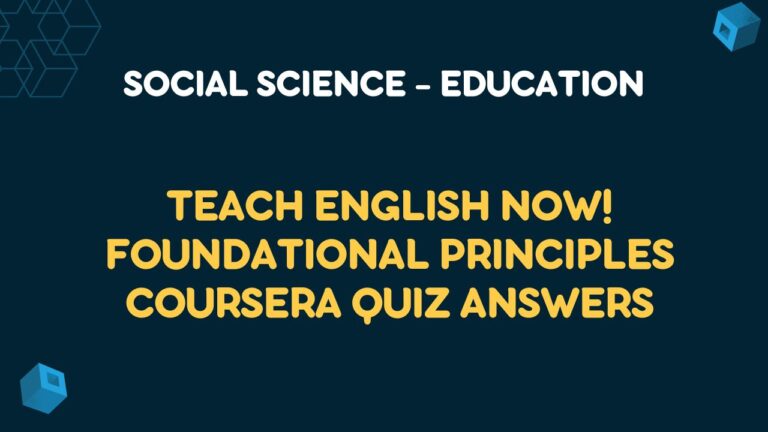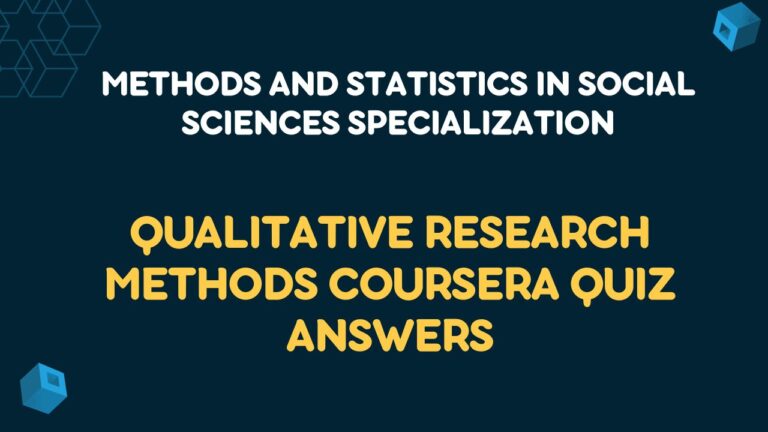Table of Contents
Get All Weeks Teach English Now! Lesson Design and Assessment Quiz Answers
Quiz 1: Checkpoint Quiz (5 Q’s)
Q1. According to the video, what are some of the roles a teacher may play?
[expand title=View Answer]
1.Coach
2.Lesson Planner
3.Psychologist
[/expand]
Q2. Which is the first event that Gagne recommends for a lesson’s introduction?
[expand title=View Answer] Gain the attention and interest of the audience [/expand]
Q3. Teacher 1 struggled with her lesson introduction. Which two issues did she have?
[expand title=View Answer]
1.She gave vague objectives.
2.She spoke too softly.
[/expand]
Q4. Teacher 2 struggled with some issues in his introduction too. Which two weaknesses did his introduction contain?
[expand title=View Answer]
1.He attempted to gain student’s attention by drawing attention to himself.
2.He didn’t share details from past instruction which could’ve sparked the class’s interest.
[/expand]
Q5. Teacher 3 successfully delivered an effective lesson introduction. What were two of her
strengths?
[expand title=View Answer]
1. She used a visual aid.
2. She asked students to raise their hands to answer simple questions.
[/expand]
Quiz 2: Checkpoint Quiz (5 Q’s)
Q1. What were Robert Gagne’s next three events discussed in the videos? Check all that apply.
[expand title=View Answer]
1.Present the content
2.Elicit Performance
3.Provide “learner guidance”
[/expand]
Q2. What is the basis of the 80/20 rule?
[expand title=View Answer] 80% of the class time should be focused on student practice while teachers should spend 20% of the time presenting information to the students.[/expand]
Q3. Select all of Teacher 1’s strengths from Video 4.
[expand title=View Answer]
1.Stimulating recall of prior learning.
2.Using diagrams and examples
3.Asking questions throughout the instruction
4.Modeling the instruction by using an example of something she wrote when she was younger
[/expand]
Q4. While Teacher 2’s lesson has some strengths, which three issues did she have with her lesson?
[expand title=View Answer]
1.She moved too quickly from presenting content to providing learning guidance.
2.She didn’t truly model exercises for students
3.She didn’t use diagrams or examples
[/expand]
Q5. What were the issues with Teacher 3’s lesson? Check all that apply.
[expand title=View Answer]
1.He didn’t provide clear instructions for the lesson.
2.He didn’t use group or pair work.
3.He didn’t model the information that he’d taught.
[/expand]
Quiz 3: Graded Checkpoint (10 Q’s)
Q1. What was the name of the man whose theories of instructional design these videos focused on?
[expand title=View Answer] Robert Gagne [/expand]
Q2. What is meant by “present by staying in the present?”
[expand title=View Answer] When you present content, be sure to do so in a lively, engaging manner that draws students in and motivates them to learn more. [/expand]
Q3. The providing “learner guidance” stage of instruction encourages students to do which 4 activities?
[expand title=View Answer]
1. Interact with each other in order to acquire language
2.Figure out how certain rules or words work
3.Make mistakes
4.Play with language
[/expand]
Q4. Benjamin Bloom, a learning theorist, suggested which 2 ideas?
[expand title=View Answer] 1. A good instructor is able to use many different methods to get students to interact with learning.
2.A good instructor is able to motivate students to think and examine information critically.
[/expand]
Q5. Which three (3) activities are examples of eliciting performance?
[expand title=View Answer]
1.A group activity
2.A test
3.A presentation
[/expand]
Q6. What are three (3) activities that can be used for presenting content?
[expand title=View Answer]
1.Demonstrating and sharing
2.Giving explicit information that will help learners understand the material
3.Speaking and presenting
[/expand]
Q7. This course will introduce you to which of the following principles?
[expand title=View Answer] Lesson Design and Assessment[/expand]
Q8. Students do not need to share what they know and be engaged in the learning process.
[expand title=View Answer]False [/expand]
Q9. In the first video, Ms. Cinco mentioned that “Super smart people learn from _ experiences” in the introduction video in hopes that participants in this course can learn both the good and bad in the course. (Choose the missing words.)
[expand title=View Answer]other people’s[/expand]
Q10. One of the most significant roles of a teacher is as a lesson planner, which generally happens when students aren’t around.
[expand title=View Answer] True [/expand]
Quiz 1: Checkpoint (5 Q’s)
Q1. Which three things should a good warm-up include?
[expand title=View Answer]
1.introducing new ideas
2.connect past ideas to new information
3.get students’ attention
[/expand]
Q2. What three things did Teacher 1 accomplish in his warm-up?
[expand title=View Answer]
1.He paired vocabulary words with pictures.
2.He introduced the day’s lesson
3.He reviewed key vocabulary words.
[/expand]
Q3. What three things did Teacher 2 accomplish in her warm-up?
[expand title=View Answer]
1.She introduced the topic for the lesson.
2.She activated students’ prior knowledge about the vocabulary.
3.She introduced new vocabulary words.
[/expand]
Q4. Which three strategies will help to engage learners from the start?
[expand title=View Answer]
1.Connect lesson plans to each other.
2.Stimulate recall of prior knowledge.
3.Connect new information to prior knowledge.
[/expand]
Q5. Students who get an A on a vocabulary test generally retain that information and can apply those words to future lessons.
[expand title=View Answer] False [/expand]
Quiz 2: Checkpoint (5 Q’s)
Q1. Which two things should a lesson plan objective include?
[expand title=View Answer]
1.A clear statement of the instructional goals for the lesson.
2.Action words such as: identify, state or demonstrate
[/expand]
Q2. A lesson plan objective should NOT include: (Choose all that apply)
[expand title=View Answer]
1. long-term goals
2. information that is not critically important to the lesson.
3. words like comprehend, understand, feel, and learn.
[/expand]
Q3. Which word is the closest in meaning to “lesson plan objectives?”
[expand title=View Answer] goals[/expand]
Q4. What are the four (4) important features of good objective discussions?
[expand title=View Answer]
1.discuss the importance of the objectives
2.establish specifics
3.clearly state the instructional objectives
4.check for understanding
[/expand]
Q5. Teachers should generally use the objectives they find in books or on the Internet to make sure they have well-written objectives.
[expand title=View Answer] False.[/expand]
Quiz 3: Graded Checkpoint (10 Q’s)
Q1. Jerome Bruner, a cognitive learning theorist, suggests that curriculum should be built:
[expand title=View Answer] in a spiral, from simple to complex. [/expand]
Q2. Which of the following are effective strategies to help students connect prior knowledge to new material? (Choose two)
[expand title=View Answer]
1.Ask students what they know about a topic in an objective discussion.
2.Include visuals, question prompts or short videos in a warm-up.
[/expand]
Q3. Which of the following ESL Activities is most likely to help students connect to previous knowledge?
[expand title=View Answer] Think, pair, square, share activities[/expand]
Q4. What three things should a warm-up lesson include?
[expand title=View Answer]
1.an “attention-getter”
2.a description of how learning will be measured
3.Introduction of new ideas
[/expand]
Q5. Knowing your objectives is important because: (select three answers)
[expand title=View Answer]
1.You will be able to clarify how and what you will instruct.
2.Students are more likely to succeed when they know their target goals.
3.You will be better able to prioritize the content of your lesson.
[/expand]
Q6. Which two features should a lesson objective include?
[expand title=View Answer]
1.A way to measure or assess learning
2.Action words like “identify, complete, match, or write”
[/expand]
Q7. Blumenfeld and Krajcik’s theory says that objectives should result in a meaningful project. An example of this might be: (Select two answers)
[expand title=View Answer]
1.A final class presentation
2.a student portfolio
[/expand]
Q8. Which of the following is the best example of a strong lesson objective?
[expand title=View Answer]Students will be able to use the simple past tense to write a paragraph describing an event in their childhood. [/expand]
Q9. Which of the following ESL Activities are good examples of measuring student understanding? (Select three answers)
[expand title=View Answer]
1.A choral reading of a new article or text.
2.A jigsaw where students present different pieces of an article or story
3.A Cloze exercise using the day’s vocabulary words
[/expand]
Q10. Which of the following are examples of objectives or content that matters?
[expand title=View Answer]
1.Include relevant examples of the 2000 most-used words in English in your course lesson.
2.Including the future perfect tense in a lesson for beginning English speakers.
3.Including necessary vocabulary to teach a specific unit theme that your lesson is based on.
4.Include the most frequently-used verb tenses (simple present, simple past, present perfect) in English in your lesson.
[/expand]
Conclusion:
Crafting engaging lessons and conducting accurate assessments are at the core of effective language teaching. By accessing the answers to the Teach English Now! Lesson Design and Assessment quiz answers, educators gain a deeper understanding of these vital aspects
British Council – Teaching English: Direct readers to the British Council’s Teaching English platform, which offers various courses, articles, and materials for language educators worldwide.
Get All Course Quiz Answers of Arizona State University TESOL Professional Certificate >>
Teach English Now! Second Language Listening, Speaking, and Pronunciation Quiz Answers
Teach English Now! Second Language Reading, Writing, and Grammar Quiz Answers
Teach English Now! Foundational Principles Coursera Quiz Answers


